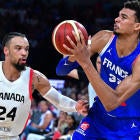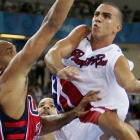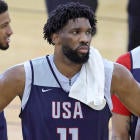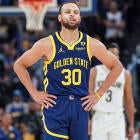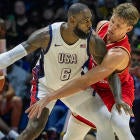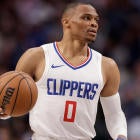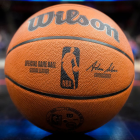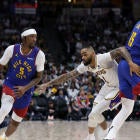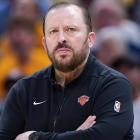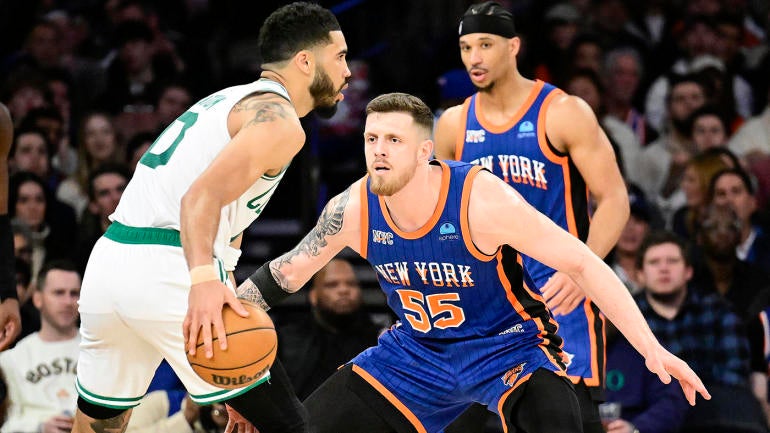
Less than a month remains in the NBA regular season and if this is when teams are supposed to round into form, then only a handful of them can feel particularly good about themselves. Between all the injuries (Minnesota, almost every relevant team in the East) and inconsistency (Dallas, Phoenix, Clippers, among others), it's OK to be a bit confused about the state of things right now.
So let's zoom out. Instead of trying to make sense of a hot or cold streak that might be meaningless, here are five stats that seem significant for the stretch run.
Donovan Mitchell, setting the pace
The Cleveland Cavaliers' transition frequency has been 3.9% higher with Donovan Mitchell on the court than without him this season, according to Cleaning The Glass. This is a big number -- LeBron James is the only player in the NBA who has increased his team's transition frequency more (minimum 500 minutes).
Why is this relevant? Because the Cavs were 19th in transition frequency (14.3%) last season and are 10th this season (15.4%), per CTG. Their tendency to walk the ball up the floor was far from the only reason they lost to the New York Knicks in the first round of the playoffs, but it was an issue. And Mitchell was often the guy who was walking it up.
Cleveland made pace a priority in training camp and this has paid off. According to CTG, only three teams have been better in transition (in terms of per-possession points added). Mitchell, one of the league's best pick-and-roll players, is extremely comfortable in the halfcourt, but he deserves credit for pushing the ball more consistently.
It helps that, along with Mitchell and Darius Garland, numerous other shooters -- Max Strus, Georges Niang and especially Sam Merrill -- are now actively looking to fire up 3s in transition. In the playoffs, the Cavaliers' spacing will still be imperfect when they have two bigs on the floor, but it'll be tougher for opponents to grind their offense to a halt.
The Pelicans, cornered
Corner 3s were not a strength of the 2022-23 New Orleans Pelicans. They ranked 26th in frequency (7.9% of their shot attempts) and 22nd in accuracy (37.4%), per CTG.
This season, that has changed drastically: In the corners, the Pelicans are 14th in frequency (9.7%) and 2nd in accuracy (42.6%). (These numbers have been even better since the All-Star break: 10.9% frequency, 46.9% accuracy.)
Much of this is because of the improvement of one player. Herb Jones' 45% mark on corner 3s isn't quite as insane as, say, Jrue Holiday's 63%, but Jones has attempted them at much higher volume and, for someone who was seen as a non-shooter until recently, it's amazing.
But it's not just Jones. Jose Alvarado, Jordan Hawkins, CJ McCollum, Larry Nance Jr., Naji Marshall and Matt Ryan are shooting a combined 47% in the corners and each of them is shooting at least 42% individually.
This isn't an accident. Before the season started, coach Willie Green said New Orleans needed to elevate its offense and brought in former Charlotte Hornets coach James Borrego to do just that. The Pelicans have built an unconventional attack around their one-of-a-kind franchise player, Zion Williamson. Still, much of their offensive improvement (10th this season, 20th last season) is because of simple stuff: Space the floor, pressure the rim, force help and find corner shooters. Brandon Ingram is seventh in the league in total corner 3s assisted and Williamson is 14th, per pbpstats.com.
Magic formula still includes FTs
Yes, fouls have been down lately. But getting to the free-throw line has remained a core part of the Orlando Magic's identity. The Magic had a league-high .298 free throw rate (i.e. FTA/FGA) before the All-Star break and since then, it has dropped to … .271, which puts them in a virtual tie with the Memphis Grizzlies for the highest rate in that span.
In a way, free throws have become a bigger advantage for Orlando recently. Before the All-Star break, in addition to generating a ton of free throws, the Magic were surrendering a ton of them -- their opponents had a .277 free throw rate, the 26th highest number in the league. Since the All-Star break, however, Orlando's opponents have had a .231 free throw rate, which is right in the middle of the pack.
Since the break, the Magic have gone 11-3, with a 10-2 record when they have a higher free throw rate than their opponent and a 1-1 record when they don't.
Paolo Banchero, Orlando's best player and best foul drawer, has seen only a slight dip in attempts. Pre-All-Star, he had a 40.5% free throw rate and averaged 10 free throw attempts per 100 possessions. Post-All-Star, he's had a .387 free-throw rate and averaged 8.8 per 100. (As a point of comparison, Damian Lillard of the Milwaukee Bucks averaged an identical 10 free-throw attempts per 100 possessions pre-All-Star, with a free-throw rate of .436. Post-All-Star, Lillard has averaged 6.7 per 100, with a free throw rate of .276.)
Conventional wisdom suggests that teams that rely heavily on getting to the free-throw line will struggle in the playoffs when calls are harder to come by. These numbers do not guarantee that Orlando won't experience that, but they are encouraging. So far, at least, the Magic's opponents have had a tougher time adjusting to the new normal than they have.
An all-defense candidate in N.Y.
Almost 85% of the way through the regular season, New York Knicks center Isaiah Hartenstein is still the league leader in defensive estimated plus-minus, according to dunksandthrees.com. I am not saying that Hartenstein has been the single best defender in the NBA, but this isn't some sort of weird statistical fluke, either.
Hartenstein was supposed to be the Knicks' backup center, but Mitchell Robinson's ankle injury in December changed that. For the first 10 games of the 2024 calendar year, the best stretch of Hartenstein's career, he averaged 8.7 points, 14.3 rebounds, 3.0 assists, 1.9 steals and 2.0 blocks in 36.1 minutes while holding down the paint for a team that suddenly was dominant defensively post-OG Anunoby trade.
Since then, neither Hartenstein nor New York has been quite on that level. He missed some time with an Achilles injury and after he returned, said he wanted to be there for the team but "probably could have sat out a couple more weeks." After playing 38-plus minutes five times in January, Hartenstein has not played more than 28 minutes in any game since the All-Star break. But he's been killing it lately -- 13 points, 10 rebounds, four assists, two steals and a block in Golden State; seven points, 14 rebounds, three assists, a steal and four blocks against Sacramento -- and the rim protection has been there consistently.
This is meaningful for a couple of reasons. Now that Robinson, who was better than ever prior to the injury, is on the verge of returning, the Knicks could have 48 minutes of elite rim protection and rebounding in the playoffs. And when it's time for awards voters to cast their ballots, Hartenstein deserves a serious look for All-Defense.
The Wemby Effect
Victor Wembanyama prooooobably won't win Defensive Player of the Year -- as he said, Minnesota Timberwolves center Rudy Gobert can have it one last time -- but he's making a legitimate case. The easy retort to "DPOY shouldn't come from a team that is currently 15-54 and 23rd in defensive rating" is "That's not Wemby's fault."
In Wembanyama's past 30 games (i.e. from Jan. 10 onward), the San Antonio Spurs have allowed 108.1 points per 100 possessions with him on the court, which is slightly better than the Minnesota Timberwolves' league-best defense (both in that span and on the season). In that same time span, the Spurs have allowed 118.8 per 100 with Wembanyama off the court, which is slightly worse than the league's 28th-ranked defense, both in that span (Los Angeles Lakers) and on the season (Atlanta Hawks).
The Wemby Effect is only slightly less extreme on the season: 111.1 points allowed per 100 possessions with him on the court, 120.1 with him off. And while these on/off numbers can be misleading -- stoppers are often off the court when the opponent's best player is off the court and the opponent's 3-point shooting often accounts for most of the differential -- these ones match what you see when you watch San Antonio: Wembanyama is an enormous deterrent and he makes defensive plays that would be impossible for anybody else.
Typically, it's true that rim protectors don't have much impact on an opponent's 3-point shooting (aside from influencing the other team to take tougher 3-point attempts when it can't get to the basket). In this case, though, I'm not convinced it's random. Wouldn't you expect opponents to shoot a lower percentage from 3 with Wembanyama on the court? His closeouts are not normal closeouts. He blocks 3s!
This is not to say that Wembanyama should necessarily win DPOY over Gobert, whose team has held opponents to 106.2 points per 100 possessions with him on the court. The rookie shouldn't be dismissed because of his team's shortcomings, though and he's earned First-Team All-Defense.
Looking for more NBA coverage? John Gonzalez, Bill Reiter, Ashley Nicole Moss and special guests dive deep into the league's biggest storylines daily on the Beyond the Arc podcast.










